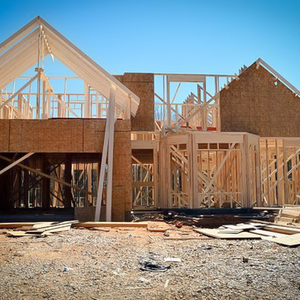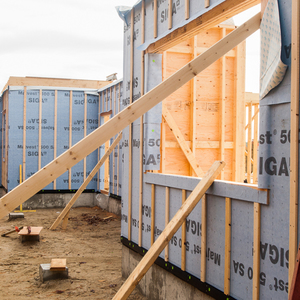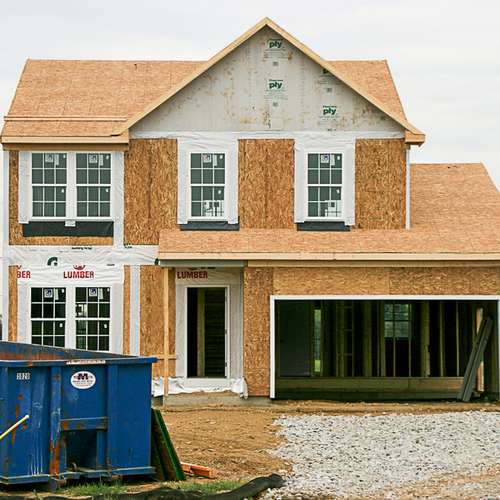
Stricter energy requirements for new construction have been dropped from a legislative package now making its way through the U.S. Senate, and critics are blaming the National Association of Home Builders (NAHB), The Washington Post reports.
The legislation, called the American Energy Innovation Act, combines dozens of energy-related proposals into a single bill (a two-page summary of the legislation can be found here). The bill has many moving parts, but the section that would have required the U.S. Department of Energy to set targets for greater efficiency in residential and commercial buildings is gone.
Sen. Lisa Murkowski, a Republican from Alaska and the chair of the Senate Energy and Natural Resources Committee, said she axed that part of the bill along with Sen. Joe Manchin, a Democrat and ranking member from West Virginia, so the entire bill might win approval.
The proposal on stricter building codes came in the form of an amendment to the Senate bill from Sen. Jeanne Shaheen, a New Hampshire Democrat, and Sen. Rob Portman, an Ohio Republication. It was supported by both business and environmental groups. As summarized by Shaheen’s office, more stringent building codes would not have been mandatory unless states and cities decided to adopt them.
Weekly Newsletter
Get building science and energy efficiency advice, plus special offers, in your inbox.
Shaheen put the blame for that decision squarely on NAHB, a trade association representing builders and what The Post called one of the most powerful lobbying groups in Washington. “This special interest group should not be allowed to derail meaningful bipartisan action on energy efficiency in Congress,” she said.
NAHB, however, was unapologetic. It said the proposal would have made buying a home more expensive.
“We don’t think that the Department of Energy should be coming in on top of state and local energy regulations and telling [them] how homes need to be built in their jurisdiction,” NAHB executive director Jerry Howard said.
NAHB has objected to stricter energy requirements for construction in the past on the grounds that some buyers would be priced out of the market. In this latest tussle, the association got some support from Sen. James Inhofe, an Oklahoma Republication. “Any effort to put the Department of Energy in the driver seat in the building code development process and set building energy efficiency targets for the commercial and residential sectors would be massive federal overreach,” he told The Post.
The NAHB chief said the association has “our grass roots on red alert” and was urging its members to phone the offices of their senators.
The American Council for an Energy-Efficient Economy said the building code provisions would cut carbon dioxide emissions by 1.18 billion tons through 2050, according to an analysis. That’s the same thing as taking 3 million cars off the road every year for the next 30 years.
NAHB has been singled out before for its efforts to slow down the adoption of code provisions that would require greater energy efficiency in new construction. Last fall, The New York Times disclosed an arrangement between the code-writing International Code Council and NAHB that made it more difficult for stricter energy provisions to win approval.
-Scott Gibson is a contributing writer at Green Building Advisor and Fine Homebuilding magazine.















17 Comments
I sit on my local HBA board, with great frustration, and question doing so all the time, but feel it’s important to be in the conversation. The latest I’m hearing is that they think a bunch of environmental groups high jacked the ICC voting process, pushing through energy code items. This kind of feels like karma considering their attempts at meddling with the process. Michigan HBA is scared to death right now (nor me so much) because we currently have a two person committee likely to rubber stamp the 2021 at the state level. Does GBA know anything about this?
Kudos to you for being on the board, Andy. I build and teach about ZNE, PH, all-electric, and energy codes in CA, and our local HBA is the only group unresponsive to attempts at getting in front of their members. They actively opposed a measure here incentivizing fossil-fuel-free construction, claiming the "new technology" was untested and unavailable for builders here. Imagine that: solar, untested and unavailable in California.
AIA and Contractor's Exchanges will bring us in and have great attendance and response/reviews, but not the HBA.
Seems like the up front cost of stricter energy requirements could be offset by more efficient, thus lower sq ft, floor plans. Maybe scrap the bonus room and second living room and instead improve insulation and air sealing?
It has less to do with NAHB's claim of a larger national entity dictating how smaller locales should be regulated, and more to do with NAHB opposing anything scratching the surface of fossil-fuel-free buildings for the future.
The president of our local HBA in California showed up to a city council vote on a Clean Energy Choice Program and opposed the measure, claiming the "new technology" (heat pumps, solar, induction cooktops) is untested and unavailable for builders. Imagine that...untested and unavailable solar in California!
Meanwhile the Rheem heat pumps sit on the floors of even the local Home Depot, rolling their eyes in disbelief, just completely unavailable to local builders according to the HBA.
Here in Maine, I'm still seeing comments and articles about how the heat pumps that keep me warm at -15° don't work in cold climates.
When we completed building our home last year, our HERS raters told us about how they were in communication with the state government (NH) to put in place a higher standard for air -tightness. They were simply proposing that the ACH figure drop from 7 ACH at 50 Pascals to 5 ACH. The NAHB stepped in and squashed it.
Our home was built at very low levels of air leakage. While the house was depressurized during our blower door test, The HERS raters opened a window to demonstrate to us what 7 ACH at 50 pascals looks like. Our 3' x 5' tilt and turn window was open NEARLY TWO FEET to the interior and maintained 7 Air changes per hour! A small person could have easily walked through the opening (were it not for the stiff breeze)!
I was stunned. Imagine all of the wasted energy and money over the life of house due to code-minimum construction...
Rick,
When I first started pressure testing my new homes in 1983/84 the test result would show the leakage area in a square inch equivalent. As I remember, for average size 2 story homes we were around 50 to 60 square inches (1.25 ACH50). Just as your example shows, a lot of little leaks can add up to equal an open window. Great reminder and my compliment to the energy rater.
Doug- I didn't realize people were testing homes for air tightness in the early 80's! Very cool.
I've talked to a couple of builders who built double stud walls in the early 80's. They would study books (real books in libraries!) about physics and solar heat gain to develop their wall details. They would stack fiber-glass batts three layers deep in the thick walls. Must have been so much fun to be on the cutting edge of building science back then! Then all was lost after the oil crisis.
I suppose American "Green Building" is a lot like Ancient Greek Philosophy. Seemingly lost for a while only to make an epic comeback later. Like the Arabs and Persians, the Germans kept the wisdom of early 80's energy efficiency in safekeeping for us to re-discover it later.
I'm not asking this as a trap or to make a point: What would green building look like from a right wing, or conservative perspective?
You would probably just use green paint.
It might be science based with a heavy dose of practical and return on investment. It would be less about making it a feel good thing. Less like religion or a hobby for the enthusiast. LOL
We all know we can double our investment and only get fractionally better. For me its mostly about the quality of the labor and supervision. I would rather have an extremely well built house than one that used $300 or whatever dollar amount less energy but built average quality. Cool specs don't make a good house.
Mike that's an interesting and thought provoking perspective. I hope more people chime in.
Mike, you might like the Pretty Good House approach. Entirely voluntary, and energy improvements are based on reasonable return on investment, instead of what production builders lobby for in the building codes. There is an important element of reducing carbon emissions, which benefits everyone. But there is nothing onerous about building with low carbon.
Well, "conservatives" and "progressives" are essentially different sides of the statist coin. IMO an example of a "conservative" solution would be instituting a ban on codes which are stricter than the federal level. Utter nonsense if you ask me.
From a libertarian perspective smaller is better so the least worst option is to let the states and localities, who know their markets best, apply whatever level of code they choose. This is important because not only is freedom of choice paramount but the associated costs are borne by the immediate consumer rather than subsidized by others in far off states or future* generations under the federal system.
*The federal system operates with little to no fiscal restraints so deficit spending falls on the backs of future generations.
On a side note IMO it seems that stricter codes levels leave less room for construction mistakes because the consequences in terms of occupant health and costs can be really high (ex, air leak causes condensation on the interior side of rigid foam and mold/wood rot develops). For example I can think of one study on some EnergyStar homes which discovered that occupants will turn off or not maintain a ventilation system. Or people do silly stuff like insist on a wood stove in a really tight house.
John's point about problems with executing and operating EnergyStar homes, to me, illustrates that a code or standard itself doesn't necessarily prevent poor quality or execution; especially if its being enacted at the local level by people who don't agree with or understand the workings and intentions of the standard—emphasis on the understand.
The issue of 'conservative' vs 'progressive' is terms of codes is kind of a toss of sand on the beach of our larger political landscape.
This underlying structure is indeed shaped by political bents. The foundational elements I'm thinking of are along the lines of economic structuring, wealth distribution, and education.
I don't think many progressives feel that regulations are a best case solution to these sorts of foundational problems, but it is a solution drafted within an environment where many fundamental social and market adjustments are sent straight to the political guillotine.
I imagine a truly conservative solution would be undermined by the liberal blockade as much as a truly progressive solution is undermined by the conservative blockade. The nature of this polarity seems to be that we get 'solutions' somewhat undesirable to everyone, but apparently not so vile to one side or the other so as to be completely decapitated (just mutated beyond recognition of the original intent).
"The junk merchant doesn't sell his product to the consumer, he sells the consumer to his product. He does not improve and simplify his merchandise. He degrades and simplifies the client."
--William Burroughs
I think most builders in this country would like to build better buildings, and most people would certainly like to live in better buildings. Too bad NAHB stands in the way of progress.
NAHB's "more expensive" means *for them*, not for the home owner. Stronger energy requirements mean better quality and lower lifetime costs to home owners. If laws supported longer home builder responsibility for maintenance, repairs, and energy costs, that tune would change in a hurry.
The state of home building in the US is shockingly poor and everybody knows it. I'm amazed NAHB can even keep a straight face while lamenting home prices... from their huge $60k trucks.
Log in or create an account to post a comment.
Sign up Log in